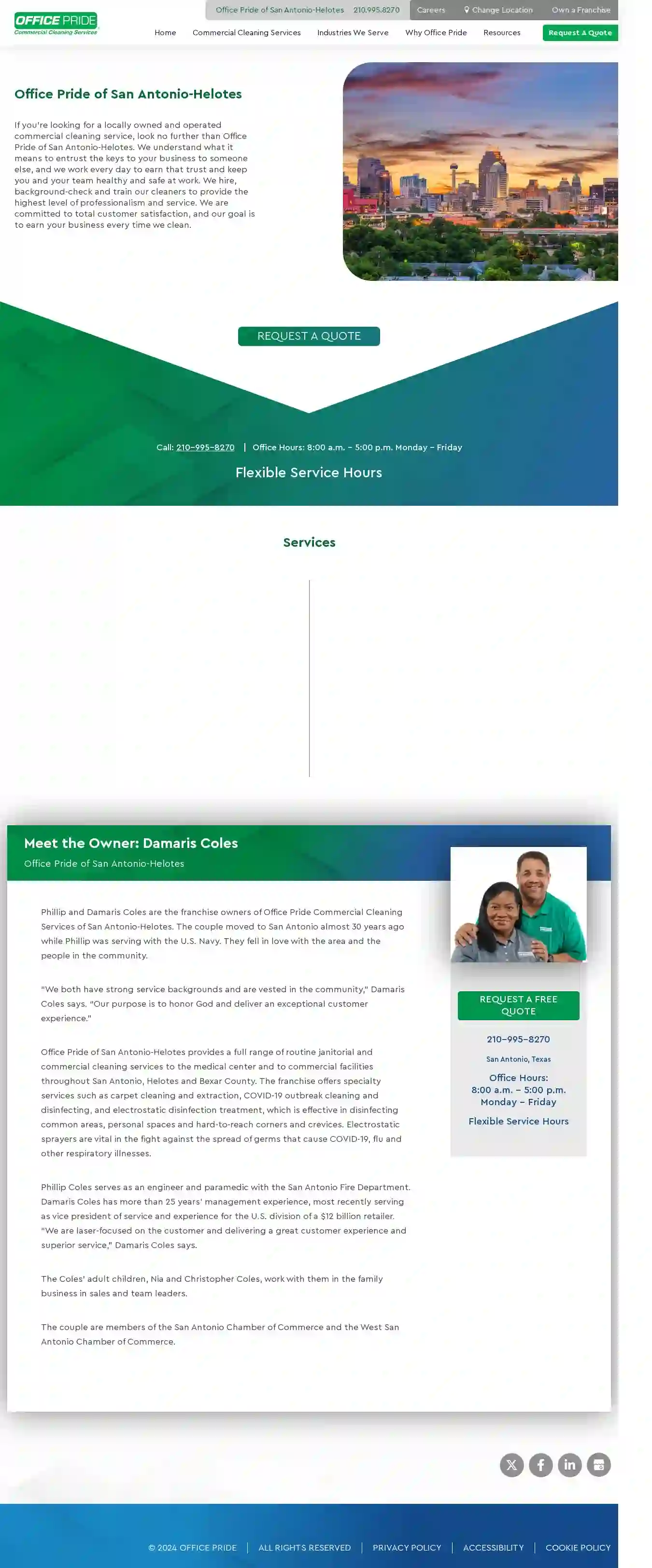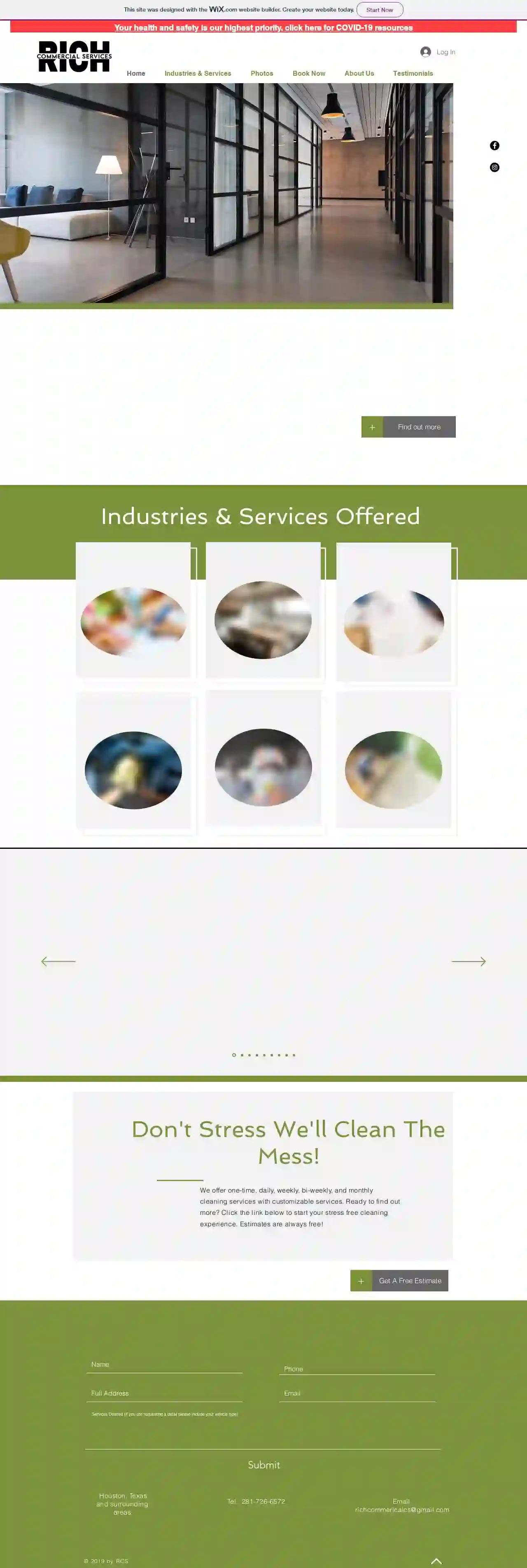Cleaning Services Hurst
Top 10 Apartment Cleaning in Hurst
Get multiple Cleaning quotes for your project today! Compare profiles, reviews, accreditations, portfolio, etc... and choose the best offer.

BB'z Housekeeping LLC
5189 reviewsSan Antonio, USBB'z Housekeeping offers high-quality cleaning for San Antonio and surrounding areas. Our core values reflect our focus on integrity and passion for what we do, our desire to build a personal relationship with our clients and help provide a cleaner, safer environment in which to live and work. We are a local, family-owned and operated cleaning service who takes pride in the quality of our work and strive to serve our community with a variety of residential and commercial cleaning service packages to fit every budget. With over 5 years of experience, we are experts at what we do! We are certified in Covid-19 residential and commercial cleaning techniques and procedures. We use CDC approved products.
- Services
- Why Us?
- Accreditations
- Our Team
- Testimonials
- Gallery
Get Quote
Office Pride Commercial Cleaning Services of San Antonio-Helotes TX
4.934 reviewsSan Antonio, TX, Helotes, 12345 Office Pride Lane, 78249, USOffice Pride of San Antonio-Helotes is a locally owned and operated franchise that provides a full range of routine janitorial and commercial cleaning services to the medical center and commercial facilities throughout San Antonio, Helotes, and Bexar County. The franchise offers specialty services such as carpet cleaning and extraction, COVID-19 outbreak cleaning and disinfecting, and electrostatic disinfection treatment. The owners, Phillip and Damaris Coles, moved to San Antonio almost 30 years ago while Phillip was serving with the U.S. Navy. They fell in love with the area and the people in the community. Their purpose is to honor God and deliver an exceptional customer experience. Office Pride of San Antonio-Helotes does not do binding annual contracts, offering flexibility and convenient payment schedules.
- Services
- Why Us?
- Accreditations
- Our Team
- Testimonials
- Gallery
Get Quote
Mark's Move In & Out Cleaning LLC
547 reviewsKilleen, US- Services
- Why Us?
- Gallery
Get Quote
Combat Cleaning Services - Carpet, Tile & Grout and Upholstery Cleaning
4.974 reviewsSan Antonio, US- Services
- Why Us?
- Gallery
Get Quote
Rich Commercial Services
4.98 reviewsHouston, US- Services
- Why Us?
- Gallery
Get Quote
System4 San Antonio
4.97 reviewsSan Antonio, US- Services
- Why Us?
- Gallery
Get Quote
Sally's Maid Service LLC
4.8222 reviewsWaco, US- Services
- Why Us?
- Gallery
Get Quote
Owl Clean
519 reviewsSpring, US- Services
- Why Us?
Get Quote- Mi
Mission Commercial Carpet Cleaning
58 reviewsMission, US- Services
- Why Us?
Get Quote - Fr
Frisco Family Cleaning Service
59 reviewsFrisco, US- Services
- Why Us?
Get Quote
Over 60,241+ Cleaning Companies onboarded
Our janitorial companies operate in Hurst and beyond!
CleaningMatch has curated and vetted Top Cleaning Companies in Hurst. Find a top & trustworthy contractor today.
Frequently Asked Questions About Cleaning Services
- Clean Pet Bedding: Wash pet bedding regularly in hot water to remove odors and bacteria.
- Vacuum Thoroughly: Vacuum carpets, rugs, and upholstery frequently using a vacuum cleaner with a pet hair attachment.
- Enzyme Cleaners: Use enzyme cleaners specifically designed for pet odors. These cleaners break down the odor-causing molecules.
- Baking Soda: Sprinkle baking soda on carpets and upholstery, let it sit for a few hours, then vacuum. Baking soda absorbs odors.
- Air Fresheners: Use air fresheners or diffusers to mask odors temporarily.
- Professional Cleaning: For persistent odors, consider hiring a professional cleaning service specializing in pet odor removal.
- Prepare the Windows: Remove dust and debris from windows using a brush, vacuum, or damp cloth.
- Cleaning Solution: Use a commercial glass cleaner or a homemade solution of equal parts water and vinegar.
- Spray and Wipe: Spray the cleaning solution onto the window, ensuring even coverage.
- Squeegee Technique: Use a squeegee to wipe the cleaner from top to bottom, overlapping each stroke by about an inch. Wipe the squeegee blade clean after each stroke.
- Dry Edges: Wipe the edges of the window with a clean, dry microfiber cloth to remove any remaining moisture.
- Ventilation: Improve ventilation by opening windows, turning on the exhaust fan, and using a dehumidifier to reduce moisture levels.
- Bleach Solution: Mix one cup of bleach with one gallon of water. Wear gloves and eye protection when handling bleach. Apply the solution to the affected area, let it sit for 10-15 minutes, then scrub with a brush and rinse thoroughly.
- Vinegar Solution: For a milder alternative, mix equal parts water and vinegar. Apply to the moldy area, let it sit for an hour, then scrub and rinse.
- Baking Soda Paste: Make a paste of baking soda and water, apply to the moldy area, let it dry, then scrub and rinse. Baking soda helps remove stains and deodorize.
- Commercial Mold and Mildew Remover: Use a commercial mold and mildew remover according to the product instructions.
- Cleaning: Removing dirt, dust, and debris from surfaces using soap or detergent and water. It improves the appearance and removes visible contaminants.
- Sanitizing: Reducing the number of bacteria on surfaces to a safe level. It uses chemical disinfectants or heat to kill or inactivate bacteria.
- Disinfecting: Killing or inactivating most disease-causing microorganisms on surfaces. It uses stronger chemical disinfectants than sanitizing and targets a wider range of pathogens.
How do I get rid of pet odors in my home?
Regular cleaning, enzyme cleaners, and baking soda are effective methods for eliminating pet odors and maintaining a fresh-smelling home.
What is the best way to clean windows without streaks?
For best results, clean windows on a cloudy day or in the shade to prevent the cleaning solution from drying too quickly and leaving streaks.
How do I remove mold and mildew from my bathroom?
Always test any cleaning solution on a small, inconspicuous area first. After cleaning, take steps to prevent future mold growth by addressing moisture issues, such as fixing leaks and improving ventilation.
What is the difference between cleaning, sanitizing, and disinfecting?
Cleaning is usually the first step, followed by sanitizing or disinfecting depending on the level of hygiene required.
How do I get rid of pet odors in my home?
- Clean Pet Bedding: Wash pet bedding regularly in hot water to remove odors and bacteria.
- Vacuum Thoroughly: Vacuum carpets, rugs, and upholstery frequently using a vacuum cleaner with a pet hair attachment.
- Enzyme Cleaners: Use enzyme cleaners specifically designed for pet odors. These cleaners break down the odor-causing molecules.
- Baking Soda: Sprinkle baking soda on carpets and upholstery, let it sit for a few hours, then vacuum. Baking soda absorbs odors.
- Air Fresheners: Use air fresheners or diffusers to mask odors temporarily.
- Professional Cleaning: For persistent odors, consider hiring a professional cleaning service specializing in pet odor removal.
Regular cleaning, enzyme cleaners, and baking soda are effective methods for eliminating pet odors and maintaining a fresh-smelling home.
What is the best way to clean windows without streaks?
- Prepare the Windows: Remove dust and debris from windows using a brush, vacuum, or damp cloth.
- Cleaning Solution: Use a commercial glass cleaner or a homemade solution of equal parts water and vinegar.
- Spray and Wipe: Spray the cleaning solution onto the window, ensuring even coverage.
- Squeegee Technique: Use a squeegee to wipe the cleaner from top to bottom, overlapping each stroke by about an inch. Wipe the squeegee blade clean after each stroke.
- Dry Edges: Wipe the edges of the window with a clean, dry microfiber cloth to remove any remaining moisture.
For best results, clean windows on a cloudy day or in the shade to prevent the cleaning solution from drying too quickly and leaving streaks.
How do I remove mold and mildew from my bathroom?
- Ventilation: Improve ventilation by opening windows, turning on the exhaust fan, and using a dehumidifier to reduce moisture levels.
- Bleach Solution: Mix one cup of bleach with one gallon of water. Wear gloves and eye protection when handling bleach. Apply the solution to the affected area, let it sit for 10-15 minutes, then scrub with a brush and rinse thoroughly.
- Vinegar Solution: For a milder alternative, mix equal parts water and vinegar. Apply to the moldy area, let it sit for an hour, then scrub and rinse.
- Baking Soda Paste: Make a paste of baking soda and water, apply to the moldy area, let it dry, then scrub and rinse. Baking soda helps remove stains and deodorize.
- Commercial Mold and Mildew Remover: Use a commercial mold and mildew remover according to the product instructions.
Always test any cleaning solution on a small, inconspicuous area first. After cleaning, take steps to prevent future mold growth by addressing moisture issues, such as fixing leaks and improving ventilation.
What is the difference between cleaning, sanitizing, and disinfecting?
- Cleaning: Removing dirt, dust, and debris from surfaces using soap or detergent and water. It improves the appearance and removes visible contaminants.
- Sanitizing: Reducing the number of bacteria on surfaces to a safe level. It uses chemical disinfectants or heat to kill or inactivate bacteria.
- Disinfecting: Killing or inactivating most disease-causing microorganisms on surfaces. It uses stronger chemical disinfectants than sanitizing and targets a wider range of pathogens.
Cleaning is usually the first step, followed by sanitizing or disinfecting depending on the level of hygiene required.